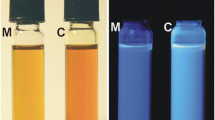Abstract
Whenever immersed in seawater after a collier accident, a fossil fuel such as coal could become a source of pollution to the marine environment. To study the effect of such a contamination, four coal samples from different origins were used. A first analysis on those coals enabled us to determine the content of polycylic aromatic hydrocarbons. Seawater was then mixed with coal to study the organic matter released from coal into seawater. Fluorescence was used for its sensitivity to aromatic compounds, with the additional purpose of evaluating the relevance of using an immerse fluorescence probe to monitor water pollution. Excitation–emission matrices were recorded and the excitation–emission wavelength range corresponding to the highest fluorescence intensity was 230 nm/[370 nm; 420 nm]. The samples with coal happened to fluoresce more than the coal-free samples, the difference depending on the coal origin. The fluorescence intensity increased with coal mass, up to some limit. The particle size also influenced the fluorescence intensity, the finest particles releasing more fluorescing substances, due to their higher exchange surface. When seawater percolated through coal, the samples fluoresced highly at the beginning, and then the fluorescence intensity decreased and reached the seawater level. However, even with a 10 ns acquisition time shift, the fluorescence spectra were not specific enough to show the presence of PAHs in the samples, which were too diluted to be detected, whenever released from coal into seawater. The lifetimes of the seawater and of the coal samples were respectively 4.7 and 3.8 ns, indicating that the substances released from coal mainly consisted of short-lived fluorescing substances, such as natural humic or fulvic substances. Consequently, the presence of coal does not seem to be too detrimental to the marine environment, and a direct fluorescence probe could be used to monitor the seawater organic charge increase due to the immersion of coal in seawater.








Similar content being viewed by others
References
Greenwood PF, George SC, Pickel W, Zhu Y, Zhong N (2001) In situ analytical pyrolysis of coal macerals and solid bitumens by laser micropyrolysis GC-MS. J Anal Appl Pyrolysis 58–59:237–253
Yoshioka H, Takeda N (2004) Analysis of organic compounds in coal macerals by infrared laser micropyrolysis. J Anal Appl Pyrolysis 71(37):137–149
Mazumdar BK (1999) Molecular structure and molar volume of organic compounds and complexes with special reference to coal. Fuel 78(9):1097–1107
Demir I, Ruch RR, Damberger HH, Harvey RD, Steele JD, Ho KK (1998) Environmentally critical elements in channel and cleaned samples of Illinois coals. Fuel 77(1–2):95–107
Alexander G, Hazai I (1981) Chromatographic fingerprinting of coal extracts. J Chromatogr 217:19–38
Zhao ZB, Liu K, Xie W, Pan WP, Riley JT (2000) Soluble polycyclic aromatic hydrocarbons in raw coals. J Hazard Mater B73(1):77–85
Chaffee AL, Johns RB (1983) Polycyclic aromatic hydrocarbons in Australian coals. I. Angularly fused pentacyclic tri- and tetraaromatic components of Victorian brown coal. Geochim Cosmochim Acta 47(12):2141–2155
Chaffee AL, Strachan MG, Johns RB (1984) Polycyclic aromatic hydrocarbons in Australian coals II. Novel tetracyclic components from Victorian brown coal. Geochim Cosmochim Acta 48(10):2037–2043
Dore SY, Laursen AE, Kulpa CF Jr (2003) Polycyclic aromatic hydrocarbon degradation in soil surrounding an outdoor coal storage pile. J Environ Eng Sci 2(3):227–231
Shorten CV, Elzerman AW, Mills GL (1990) Methods for the determination of PAH desorption kinetics in coal fines and coal contaminated sediments. Chemosphere 20(1–2):137–159
Burel L, Giamarchi P, Stephan L, Lijour Y, Le Bihan A (2003) Molecular and atomic ultra trace analysis by laser induced fluorescence with OPO system and ICCD camera. Talanta 60(2–3):295–302
Giamarchi P, Burel L, Stephan L, Lijour Y, Le Bihan A (2002) Laser-induced fluorescence with an OPO system. Part I. Optimisation of the analytical system by the use of experimental design methodology. Application to the direct quantification of traces of benzo[a]pyrene. Anal Bioanal Chem 374:490–497
AFNOR. Avant-projet de norme soumis à enquête probatoire jusqu’au 5 janvier 2004-Pr NF ISO 18287 X31-170
United States Public Law 100-4. Water Quality Act. 1987
Decision No 2455/2001/EC of the European Parliament and of the Council of 20 November 2001 establishing the list of priority substances in the field of water policy, 2001
French standard leaching tests of solid wastes. X31-210. AFNOR édition, France
Bayrakceken S, Gaines AF, Keating P, Snape CE (2005) The fluorescence of suspensions of powdered coals. Fuel 84(14–15):1749–1759
Sierra MMD, Giovanela M, Parlanti E, Soriano-Sierra EJ (2005) Fluorescence fingerprint of fulvic and humic acids from varied origins as viewed by single-scan and excitation/emission matrix techniques. Chemosphere 58(6):715–733
Antunes MCG, Esteves da Silva JCG (2005) Multivariate curve resolution analysis excitation–emission matrices of fluorescence of humic substances. Anal Chim Acta 546(1):52–59
Kang KH, Shin HS, Park H (2002) Characterization of humic substances present in landfill leachates with different landfill ages and its implications. Water Res 36(16):4023–4032
Antízar-Ladislao B, Lopez-Real J, Beck AJ (2006) Investigation of organic matter dynamics during in-vessel composting of an aged coal-tar contaminated soil using fluorescence excitation–emission spectroscopy. Chemosphere 64(5):839–847
Peuravuori J, Koivikko R, Pihlaja K (2002) Characterization, differentiation and classification of aquatic humic matter separated with different sorbents: synchronous scanning fluorescence spectroscopy. Water Res 36(18):4552–4562
Gaines A, Öztas N, Sur M, Yürüm Y (2004) The Fluorescence of the Black Sea and the Rhodes Gyre, Eastern Mediterranean. Turk J Eng Environ Sci 28(3):191–206
Alberts JJ, Takács M (2004) Total luminescence spectra of IHSS standard and reference fulvic acids, humic acids and natural organic matter: comparison of aquatic and terrestrial source terms. Org Geochem 35(3):243–256
Chen J, LeBoeuf EJ, Dai S, Gu B (2003) Fluorescence spectroscopic studies of natural organic matter fractions. Chemosphere 50(5):639–647
Author information
Authors and Affiliations
Corresponding author
Rights and permissions
About this article
Cite this article
Jaffrennou, C., Stephan, L., Giamarchi, P. et al. Direct Fluorescence Monitoring of Coal Organic Matter Released in Seawater. J Fluoresc 17, 564–572 (2007). https://doi.org/10.1007/s10895-007-0216-y
Received:
Accepted:
Published:
Issue Date:
DOI: https://doi.org/10.1007/s10895-007-0216-y




